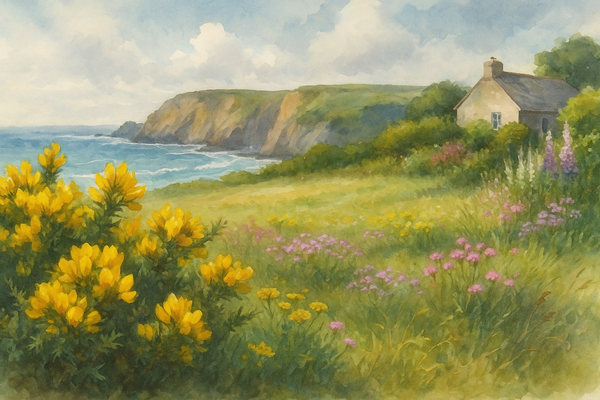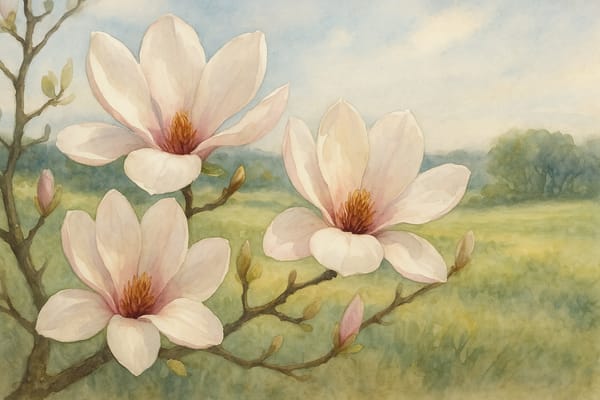How Cornwall’s granite-rich soils, salt winds, and ancient flora give rise to a scent signature that can only come from here.
A Breath of Cornwall
There are places in the world where memory arrives on the wind. Cornwall is one of them. Long before you glimpse the curve of a cove or the lichen-laced stone of a Cornish gatepost, you might catch the scent—something floral, something herbal, something just a little wild. It’s the fragrance of crushed camomile after rain, of gorse sun-warmed to coconut and vanilla, of salt carried in from the Atlantic and tangled through the hedgerows.
It’s not the perfume of any single plant, but the result of many and shaped by soil, wind, and tradition. This is fragrance terroir. And in Cornwall, it speaks louder than words.
What Is Terroir in Fragrance?
Terroir, a term from wine and culinary traditions, refers to how a landscape’s geology, climate, and cultivation methods shape a plant’s flavour or scent. In the context of perfume, it reflects the impact of local environmental conditions on the volatile organic compounds (VOCs) that give plants their unique aromatic signature.
In Cornwall, this phenomenon is particularly vivid. The region’s wind-stressed hillsides, mineral soils, and mild, humid climate imprint a distinctive scent profile on native flora—so distinctive, in fact, that it has been demonstrated through GC-MS (gas chromatography–mass spectrometry) studies comparing Cornish-grown plants with their inland or foreign counterparts.
The Scented Landscape: Cornwall’s Aromatic Conditions
1. Mineral Soils and Aromatic Defence
Cornwall’s soils, derived from granite, slate, and serpentine, are naturally low in organic content and highly mineralised. These lean, well-drained conditions prompt plants to increase their secondary metabolites—such as essential oils—as a defence mechanism against stress. This phenomenon has been demonstrated in field and lab studies of basil, sage, and thyme, where low-nutrient soils yielded oils with higher terpene concentrations.
In Cornwall, this response manifests in the sharper, more complex aromas of lavender, mint, and thyme grown in situ—compounds chemically altered by the soil’s calcium, magnesium, and silica content.
2. Salt Air and Microclimate Variability
The region’s oceanic climate, cool, humid, and saline, is a well-documented driver of increased oil production in aromatic species. Salt-laden winds and variable temperatures trigger plants to release more terpenes and esters, often in unusual ratios. Comparative studies confirm that coastal exposure increases the presence of lactones in gorse (Ulex europaeus), enhancing its creamy, coconut-like notes, and esters in camomile (Chamaemelum nobile), giving it a brighter, fruitier top note.
In Cornish lavender, GC-MS analyses have confirmed elevated levels of linalool and linalyl acetate—compounds associated with both fragrance quality and neurological effects like stress reduction.
Sheltered microclimates within Cornwall’s valleys and hedgerows also allow tender or hybrid species to thrive. This creates aromatic landscapes richer than those of many inland counties—an outcome supported by local biodiversity records and climate mapping studies.
3. A Botanist’s Paradise
According to The New Atlas of the British and Irish Flora, Cornwall holds the highest recorded native flora count of any English county, with over 1,000 species and more than 60 considered nationally rare. This includes fragrant and culturally significant plants such as:
- Sea thrift (Armeria maritima): salt-spiced, floral, resilient
- Meadowsweet (Filipendula ulmaria): almond-powdery, hay-like
- Wild honeysuckle (Lonicera periclymenum): sweet, nostalgic, powerful
- Coastal thyme (Thymus polytrichus): herbal, cooling, layered
These plants’ scent profiles are directly shaped by environmental exposure. Scientific models have shown that even genetically identical plant strains will yield different oil compositions depending on local soil texture, salt content, and elevation.
The Chemistry of Place
Multivariate statistical analyses—such as principal component analysis (PCA)—have confirmed that plants grown in different soil and climate conditions produce chemically distinct oils, even within the same species. A landmark study on thyme essential oils demonstrated that changes in soil potassium, nitrogen, and phosphorus alter the balance of key constituents like thymol and carvacrol. Similar results have been reported for lavender and basil grown under variable mineral conditions.
Cornwall’s geological and meteorological profile creates a unique chemical environment where:
- Gorse accumulates high levels of lactones and fatty volatiles
- Camomile favours ester production near the coast
- Lavender from coastal plots exceeds inland crops in both fragrance complexity and therapeutic value
These results align with controlled studies conducted in Mediterranean regions, showing the crucial role of terroir in aroma outcomes ([Volatile Composition of Herbs, Spain, 2016]; [Siparuna muricata Oil Study, 2021]).
The Human Element: Heritage and Craft
Cornish hedgerows, with their ancient layering of stone, soil, and seasonal bloom, serve as narrow ecosystems for many of these scent-rich species. This landscape has not only hosted native herbs and flowers for centuries—it has preserved their genetics, behaviours, and scent expressions through natural regeneration.
Modern growers are building on this legacy. At Trenow Fields, lavender and other aromatics are grown regeneratively and distilled using slow, cold-extraction methods—known to preserve delicate top notes and maximise volatile complexity. Brands like The Cornish Scent Company focus on traceable, small-batch essential oil production, often citing terroir as a unique selling point.
How Cornwall Compares: Grasse and Beyond
| Characteristic | Cornwall | Grasse, France | Mediterranean (e.g., Italy) |
|---|
| Climate | Oceanic, humid, cool summers | Mediterranean, dry summers | Hot, long summers, dry |
| Soil | Granite, slate, serpentine | Clay-limestone | Volcanic, chalk, clay |
| Aromatic Plants | Gorse, camomile, thrift, mint | Rose, jasmine, lavender | Myrtle, thyme, citrus |
| Scent Profile | Fresh, herbal, mineral, saline | Sweet, dense, powdery florals | Warm, resinous, earthy |
The contrast is more than climate deep. Cornwall’s cool temperatures and constant airflow foster what perfumers call a “living scent”—light, evolving, layered—less opulent than the florals of Grasse, and more vegetal and salty than the sun-thick notes of Mediterranean blends.
Emotion, Memory, and Olfactory Science
Modern neuroscience confirms what gardeners and perfumers have long known: scent is uniquely tied to memory. Odour molecules reach the brain’s limbic system within milliseconds, bypassing rational thought and touching emotion directly. The coconut-vanilla of flowering gorse, or the green sweetness of mint crushed underfoot, can evoke entire childhoods.
Cornish fragrances offer not just olfaction but return—to place, to season, to story.
Climate Change: Risk to the Aromatic Landscape
Cornwall’s floral future is not guaranteed. A long-term ecological survey published in PLOS ONE (2018) found that over 19 native plant species, including moisture-loving aromatics like meadowsweet and water mint, have suffered significant habitat contraction in West Cornwall due to climate shifts.
At the same time, rising temperatures and erratic rainfall may intensify certain plant oils—a stress response that boosts terpene and ester output. However, prolonged stress, drought, and invasive species could undermine biodiversity and reduce the delicate layering of the region’s scent profile.
To mitigate these threats, local growers are employing seed-saving protocols, adaptive planting strategies, and biodiversity-led land management—all in hopes of preserving the olfactory character of Cornwall’s flora for future generations.
A Land Distilled
To wear a Cornish fragrance is to wear a living map—one drawn in scent, memory, and mineral. It carries salt wind, summer rain, and the soft persistence of thyme in bloom. No synthetic formula, no industrial replication, can mimic the effect of place. What makes Cornish fragrance so compelling is that it is of the land, shaped by its geology, climate, and care.
In a world craving authenticity, the Cornish note stands as something real. Something rooted. And something that, with care, can last.











